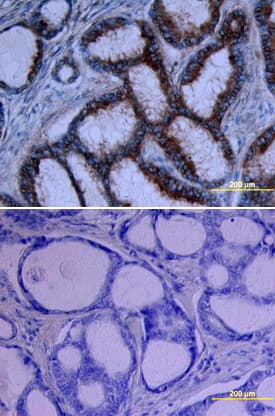Human Growth Hormone R/GHR Biotinylated Antibody
R&D Systems, part of Bio-Techne | Catalog # BAF1210


Key Product Details
Species Reactivity
Applications
Label
Antibody Source
Product Specifications
Immunogen
Ala27-Tyr264
Accession # P10912
Specificity
Clonality
Host
Isotype
Scientific Data Images for Human Growth Hormone R/GHR Biotinylated Antibody
Growth Hormone R/GHR in Human Breast Cancer Tissue.
Growth Hormone R/GHR was detected in immersion fixed paraffin-embedded sections of human breast cancer tissue using Goat Anti-Human Growth Hormone R/GHR Biotinylated Antigen Affinity-purified Polyclonal Antibody (Catalog # BAF1210) at 15 µg/mL overnight at 4 °C. Tissue was stained using the Anti-Goat HRP-DAB Cell & Tissue Staining Kit (brown; Catalog # CTS008) and counterstained with hematoxylin (blue). Lower panel shows a lack of labeling if primary antibodies are omitted and tissue is stained only with secondary antibody followed by incubation with detection reagents. View our protocol for Chromogenic IHC Staining of Paraffin-embedded Tissue Sections.Applications for Human Growth Hormone R/GHR Biotinylated Antibody
Flow Cytometry
Sample: Human whole blood CD19+ B cells
Immunohistochemistry
Sample: Immersion fixed paraffin-embedded sections of human breast cancer tissue
Western Blot
Sample: Recombinant Human Growth Hormone R/GHR Fc Chimera (Catalog # 1210-GR)
Formulation, Preparation, and Storage
Purification
Reconstitution
Formulation
Shipping
Stability & Storage
- 12 months from date of receipt, -20 to -70 °C as supplied.
- 1 month, 2 to 8 °C under sterile conditions after reconstitution.
- 6 months, -20 to -70 °C under sterile conditions after reconstitution.
Background: Growth Hormone R/GHR
Growth hormone (GH), also known as somatotropin, is a member of a family of growth factors that includes prolactin, placental lactogens, proliferins and somatolactin (1, 2). It is synthesized primarily by somatotropes in the anterior pituitary and is released as an endocrine hormone. Other cells and tissues, including lymphoid tissues, can also produce GH (3). GH is a pleiotropic molecule which can act directly or indirectly via IGF-I, to regulate growth and metabolism as well as enhance T cell survival and thymic functions (1, 2, 4). GH exerts its biological actions by binding to the GH receptor (GHR) that is present in many cell types (1, 2). Human GHR cDNA encodes a 638 amino acid (aa) residue type I transmembrane protein with an 18 aa putative signal peptide, a 246 aa extracellular domain, a 24 aa transmembrane domain and a 350 aa cytoplasmic domain (5). At least two alternatively spliced isoforms of human GHR, lacking the sequence encoded by exon 3, or lacking most of the cytoplasmic domain, also exist (6, 7). Soluble GH-binding proteins corresponding to extracellular domain of the transmembrane proteins can be generated from the membrane proteins (8). Ligation of GHR by GH has been shown to result in receptor dimerization and activation of the JAK/STAT signaling cascade (9). The soluble GHBP has been shown to interfere with GH signaling by competing with the transmembrane receptor of GH. Alternatively, the GHBP has also been shown to enhance GH action by slowing GH clearance (8, 10).
References
- Goffin, V. et al. (1996) Endocrine Rev. 17:385.
- Le Roith, D. et al. (2001) Endocrine Rev. 22:53.
- Clark, R. (1997) Endocr. Rev. 18:157.
- Welniak, L.A. et al. (2002) J. Leukoc. Biol. 71:381.
- Leung, D.W. et al. (1987) Nature 330:537.
- Stallings-Mann, J.L. et al. (1996) Proc. Nat. Acad. Sci. 93:12394.
- Amit, T. et al. (1997) Endocr. Metab. 82:3813.
- Ross, R.J.M., et al. (1997) Molecular Endocrinology 11:265.
- Carter-Su, C. et al. (1996) Annu. Rev. Physiol. 58:187.
- Postel-Vinay, M.C. and J. Finidori (1995) Eur. J. Endocrinol. 133:654.
Long Name
Alternate Names
Gene Symbol
UniProt
Additional Growth Hormone R/GHR Products
Product Documents for Human Growth Hormone R/GHR Biotinylated Antibody
Product Specific Notices for Human Growth Hormone R/GHR Biotinylated Antibody
For research use only